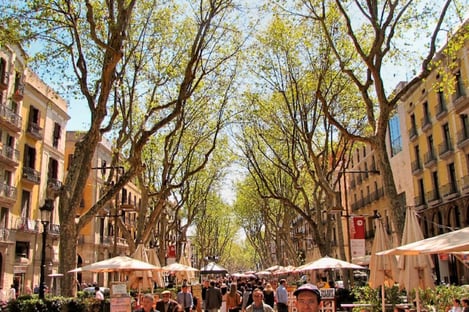La Rambla is 1.2 km long and connects the centre of Barcelona, the Plaza de Catalunya in the north, to the port of Barcelona in the south, where the statue of Christopher Columbus is located. If you take a closer look at the names of this street, you will often hear that it is called "Las Ramblas", which is the plural preposition in Spanish, and you may wonder why only one street is called in the plural. In fact, Rambla Street is also composed of 5 different streets that connect to the main street of La Rambla. The other 5 streets that eventually connect the main street that connects the city centre to the port are the Rambla de Canaletes, the Rambla dels Estudis, the Rambla de Sant Josep, the Rambla dels Caputxins and the Rambla de Santa Mònica. Originally, the stunning La Rambla street that attracts millions of tourists was built as a sewer system, yes, it seems incredible to us too! This huge covered waterway that diverted sewage to the sea became the centre of activities over time and in the 18th century, when the walls surrounding the city of Barcelona were demolished, La Rambla street entered the city which had until then been outside and served as a culvert.
La Rambla is famous and infamous for everything you know about Barcelona and it's a place where you can find your own sense of fulfilment! The numerous tapas bars, florists, pretty souvenir stores, all brimming with people, will not fail to enchant you. Walking towards the port, at the end of the street, you will notice many street artists performing a variety of arts such as painting, dance, music and all kinds of activities full of energy and vibrancy. The street is lined with lush green trees on the sides, planted in the 18th century, which adds to its beauty. La Rambla, historically, and even until recently, had stalls selling exotic birds, hamsters, iguanas and other smaller animals, which is now prohibited under animal protection laws. This is just one example of how this historic street has changed and evolved in its function and face.
The Rambla was also a favourite place for admiring its beauty for personalities like Antoni Gaudi, in fact one of the plazas next to the Rambla called Plaza Reial was designed by Gaudi himself, the square is picturesque with lampposts, pillars and fountains. Another emblematic place is the Canaletes Fountain in the middle of the main street of La Rambla which was built in 1892, the fountain is ornamental and is surmounted by a lamppost, the fountain is supposed to have the best water in Barcelona and was also part of an exposition in 1888.
>>> 137 years of Barcelona's Architectural Brilliance: La Sagrada Familia
